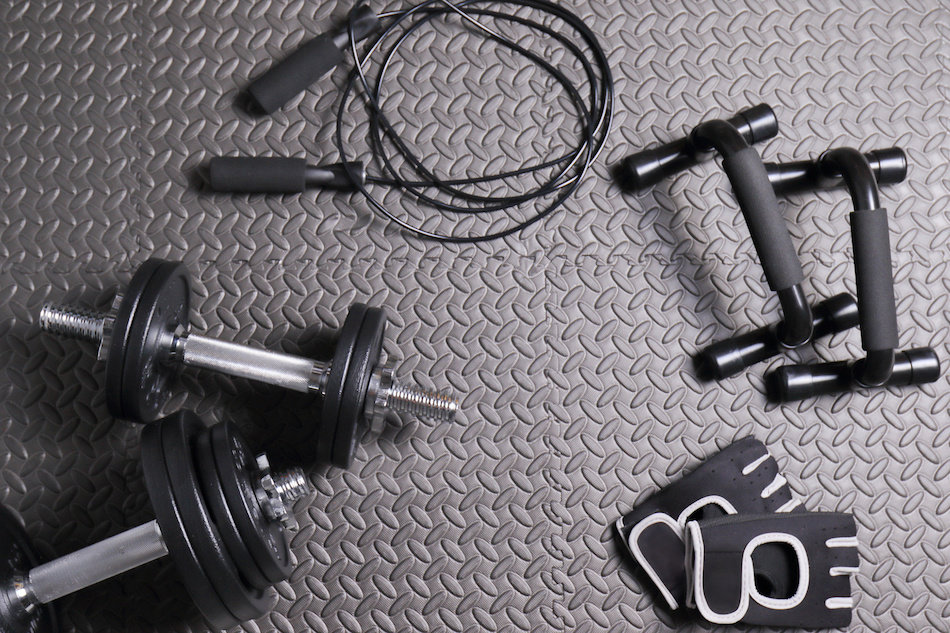How to Build a Home Gym
Posted by Lauren Schneider on Wednesday, May 8th, 2019 at 1:21pm.
 For many fitness enthusiasts, staying in shape isn't limited to visits to the gym. Building a home training studio is a rewarding project that involves careful planning before plugging in that treadmill. Here's what to keep in mind for this home improvement.
For many fitness enthusiasts, staying in shape isn't limited to visits to the gym. Building a home training studio is a rewarding project that involves careful planning before plugging in that treadmill. Here's what to keep in mind for this home improvement.
Location, Location, Location
An effective home gym is more than an empty room full of equipment here and there. Start by picking the best room in your residence. It should be large enough to hold the equipment necessary and situated in a spot that discourages noise transmission. An 8-foot ceiling is ideal to accommodate headroom for tall equipment and for stretching. A basement is often the first choice. A second option might be a guest bedroom. Since working out generates significant noise, avoid choosing a room that shares a wall with an occupied bedroom.
What's on the Floor?
Flooring material is possibly one of the most important aspects of a home training studio. Three attributes are musts for studio flooring:
- Comfort
- Durability
- Easy to clean
Two potential problems are sufficient support for heavy equipment like treadmills and marks from equipment or from water or sweat drips. While hardwood floors and carpeting have drawbacks, resilient flooring made of material such as rubber is a good alternative. Vinyl plank is also an option. If changing existing flooring is impractical, consider rubber anti-fatigue mats. For the best flooring choice, consult a professional.
Light and More Light
Lighting in your home gym is very important and serves two purposes. The room needs to be bright enough to exercise safely. It's also nice to have an ambience that fosters relaxing activities such as yoga. Being able to dim room lights is helpful. Low-voltage track lights are a good choice. To balance shadows and increase room appeal, consider a few overhead fluorescent lights and incandescent side or up-lights.
Power Up
The equipment you intend to use will determine power needs. The number of pieces and their respective sizes might warrant adding dedicated electrical circuits. Managing cords on large pieces of equipment is a safety issue. This is one home improvement well suited to the expertise of an electrician or other contractor.
Use It, Store It
Beyond providing enough space for big pieces of equipment such as weight machines, a home training studio requires storage for smaller pieces like ropes, dumbbells, and workout videos. Also plan a spot in which to set drinks and allow for hooks for clothing and towels.
In Praise of Mirrors
Mirrors are essential to staying balanced and working on form. The best choice is a floor-to-ceiling mirror covering an entire wall. Also worth considering is putting a frame around the perimeter to keep balls or other pieces of flying equipment from damaging a mirror.
Air In, Air Out
A home gym requires ventilation adequate for combating heat and humidity generated during workouts. If possible, a home gym needs at least one window that opens for air circulation. Other alternatives are air conditioning or a ceiling fan.
Get Entertained
Many marathoners prefer some sort of entertainment while working out. A percussion beat or a trending musical score might be just the thing to rev up a session. For those who find music distracting, watching a movie or a TV show is sometimes motivating. When creating a home training studio, be sure to include necessary space and equipment for entertainment needs.
Style Reality Check
After considering everything you need in a home studio, it's wise to do a reality check before finalizing plans. A home gym should be an enjoyable space to occupy. It should express personal style and match the style of the rest of the home. Whether it has a spa-like atmosphere or the best stereo system available, it should include all the features that make it desirable to spend time there.
The Right Stuff
Once plans for the studio are in place, it's time to populate it with equipment you already own plus some additional pieces. Include only equipment that will help meet your goals. Find it via online research, consulting with retailers, and talking with fitness experts. Make sure to diagram the placement of all the equipment you plan to put in the studio. Including pieces you plan to add over time helps determine exactly where to put electrical outlets.
The Best Equipment For an At-Home Gym
Most people do not have as much room for a gym as they'd like. Because of this, every piece of equipment has to count. These items can allow home gym owners to get the most out of every item.
- Resistance bands can provide versatile strength and flexibility training while taking up little space. Choose a range of sizes.
- Kettlebells come in a range of sizes and allow for many different exercises in a small space. Trade out lighter bells for heavier ones when gaining strength.
- Balance balls help with posture and flexibility, as well as providing a powerful core workout.
When upgrading your home gym, start small, with basic equipment that can work out different parts of your body, then upgrade to larger or more expensive equipment over time.
Building a home training studio is both an exciting and a challenging home improvement project. Just keep in mind the location, personal style and equipment that will be in the room.
